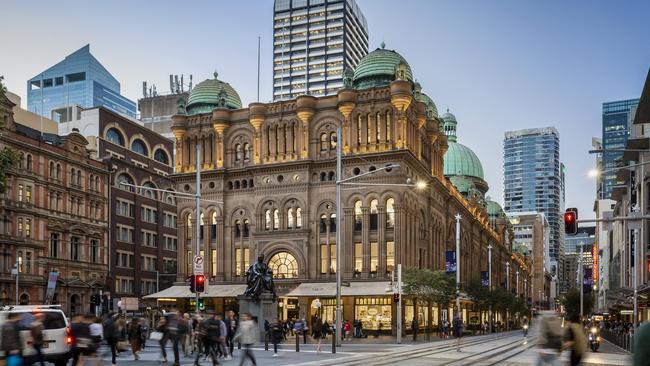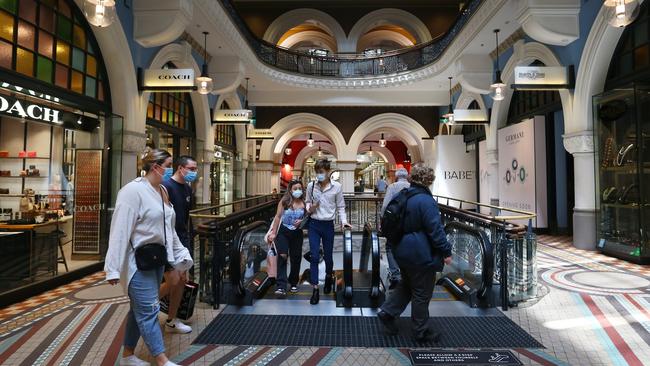Link joins the dots on city retail recovery with move on QVB
The Hong Kong major is at the vanguard of property groups buying into the local market to ride the comeback of central business districts.

The recovery of large malls is picking up steam as the economy reopens with big investors swooping on interests in city properties even amid warnings they will take a long time to recover.
In the largest deal for city retail assets since the pandemic began, Hong Kong’s Link REIT has snapped up half stakes in three of the country’s best loved shopping centres – The Queen Victoria Building, The Galeries and the Strand Arcade – in the heart of Sydney for $538.2m.
The heritage-listed late-nineteenth-century QVB is the second most visited site in the city after Opera House, and The Strand Arcade, also heritage-listed, is a unique proposition for local customers, while the Galeries is a lifestyle and cultural destination for fashion, art and dining.
The purchase of the slices in the trio of assets from Singaporean sovereign fund GIC is one of the first solid signs that city retail will come back from the pandemic, as states accelerate their plans for economic reopening.
Link chairman Nicholas Allen said the move would diversify the company’s holdings in Australia, where it already owns a Sydney office block.
“The acquisition of this prime retail portfolio is part of our Vision 2025 growth strategy to diversify and improve our portfolio mix. We are excited to have captured an opportune moment to invest in these iconic Australian retail assets,” he said.
Link chief executive George Hongchoy said the properties, co-owned by the listed Vicinity Centres, were a “rare portfolio, sitting in the heart of Sydney CBD”.
“Given the high occupancy rate filled with leading Australian and international brands, the portfolio is well-positioned to capture the retail rebound with the improving consumption sentiment in the country,” he said.
“Coupled with the strategic partnership with a leading retail asset manager in Australia, we believe both parties will jointly enhance the portfolio to ensure these landmark assets will deliver the best retail experience to all shoppers and unlock their long-term growth potential,” Mr Hongchoy added.
The Sydney CBD assets have weathered the storm and Link said that the portfolio occupancy stood at 94.3 per cent. The portfolio has strong productivity in terms of total moving annual turnover per square metre with the Strand Arcade and QVB are ranked first and second in Australia and the Galeries ranked fourth in specialty trading.
Since 2018, the portfolio has been managed by Vicinity, it will stay on as the co-owners look to position the portfolio “dynamically” as city shoppers return.
But a full recovery may take time and local trust GPT warned on Friday that its Melbourne Central property would make a slow comeback, although it expects its other malls to see strong trading.

GPT chief executive Bob Johnston said extensive retail trading restrictions hit performance during the September quarter, hurting cash collections as few stores were open in Sydney and Melbourne,
“The recent easing of COVID-19 restrictions and reopening of non-essential retail in NSW and Victoria is welcomed, and early indications suggest we will see customer visitations at our shopping centres return to levels experienced prior to the lockdowns,” he said.
But Mr Johnston said the recovery of GPT’s Melbourne Central shopping centre “is likely to be more protracted given its reliance on the return of office workers, students and visitors to the Melbourne CBD”.
The Sydney deal is a coup for Link REIT, Asia’s largest real estate investment trust, which had already been buying in China and Britain in the wake of the pandemic.
It forged into Australia two years ago, snapping up an office building beside Westfield Sydney from US private equity company Blackstone for about $683m.
Link REIT worked on the latest deal with local funds manager EG, which it tapped in March to support its expansion in Australia.
The sale was brokered by CBRE’s Simon Rooney and Colliers’ Lachlan MacGillivray.
Mr Rooney introduced Link REIT and EG Funds, Link REIT’s investment manager in Australia, and ran a sales campaign jointly with Mr MacGillivray.
The deal, struck on a core capitalisation rate of 5 per cent, was the largest CBD shopping centre transaction since late 2017, when Vicinity picked up its half interest in the same trio of centres.
“The Link REIT/EG acquisition is expected to instil further confidence into Australia’s retail investment sector, demonstrating the enhanced institutional demand for core retail assets and the ongoing investor confidence in the future of CBD retailing,” Mr Rooney said.
“Assets of this scale, quality and reputation are rarely sold and in the case of The Queen Victoria Building, The Strand Arcade and The Galeries, this was the first time the portfolio had been publicly offered to the market. These iconic centres are regarded as among the best in Australia and dominate Sydney’s core retail precinct, which is positioned for recovery following the end of lockdowns, as workers, tourists and shoppers return to the CBD,” he said.
CBRE data shows that almost $4.52bn flowed into Australian retail investments in the last two quarters – an 118 per cent jump on last year and ahead even of spikes in office and industrial transactions.
EG’s head of capital transactions, Sean Fleming, said that city retail assets could benefit from an upswing. “These prime assets rarely come to market and are well placed to benefit from workers returning to their offices in the Sydney CBD and the reopening of Australian borders to international visitors,” he said.
EG has remained confident in the recovery of Sydney’s core retail precinct and the good relative value of such rare prime assets despite the short-term challenges in retail. “We took the opportunity to secure the portfolio off-market,” Mr Fleming said.
Link REIT’s move on the three shopping centres comes after city economies were slugged by lockdowns in Sydney and Melbourne. This prompted speculation about underused office buildings being turned over to other uses, but the big money is now paying up for premium office and retail assets in the city.
Vicinity – which co-owns the centres and manages them – had called out the weakness of its city properties at its results, but expects them to recover.
The Sydney centres also differ from large regional malls in the suburbs, which have struggled to draw back in customers despite being promoted as lifestyle destinations. The three centres offer exposure to classic strips such as Pitt Street Mall, which ranks among the world’s most expensive strips, and George St, which has been transformed by the light rail.
In 2017, Vicinity and GIC agreed to swap assets worth a combined $1.1bn, which cut the Singaporean fund’s exposure to the city assets.
The groups exchanged a 49 per cent stake in Vicinity’s Chatswood Chase in Sydney, worth $562.3m, for a 50 per cent stake in GIC’s Queen Victoria Building, The Galeries and The Strand Arcade, worth $556m. The swap allowed Vicinity to gain exposure to the Sydney CBD centres, and it stayed on as manager.
Vicinity valued its half stake in the QVB at $270.3m and it was held at a 5.13 per cent capitalisation rate. The company held its stake in The Galeries City Centre at $146.5m at 5 per cent and its interest in The Strand Arcade at $109.4m at 4.75 per cent. All up the Link deal appears to be just above these values.
Top city centres could benefit from retail store consolidation and retailers targeting high-quality locations as there is still active leasing of flagship stores in its premium assets, notably in CBDs, with general fashion, sports, home and luxury tenants expanding.
In June, Charter Hall teamed up with Abacus Property Group to swoop on a two-thirds stake in the landmark Myer Melbourne building in Bourke St for $270.4m. Singapore’s GIC and fund manager Nuveen sold down and the new pair came in alongside manager and one-third investor Vicinity.




To join the conversation, please log in. Don't have an account? Register
Join the conversation, you are commenting as Logout